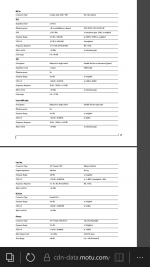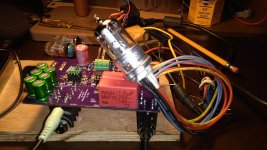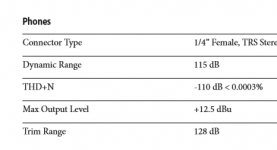Motu m4 looks good. An order better than my ur22ii.
https://cdn-data.motu.com/manuals/usb-c-audio/M_Series_User_Guide.pdf
https://cdn-data.motu.com/manuals/usb-c-audio/M_Series_User_Guide.pdf
Attachments
Well I ordered the M2 from B&H Photo, they have the m4 and m2 in stock but dont know how many.
$169 delivered.
I read the manual and noticed the trs on output needs an open circuit on ring 1/4" line out.
So to do a loopback have to make a cable. No problemo.
It includes the USB-C to USB3 cable adapter.
Actually I need the MIDI but will go back and order the M4 if all works out.
May as well try out REW at same time. I like the presentation plots as opposed to screen captures currently using.
$169 delivered.
I read the manual and noticed the trs on output needs an open circuit on ring 1/4" line out.
So to do a loopback have to make a cable. No problemo.
It includes the USB-C to USB3 cable adapter.
Actually I need the MIDI but will go back and order the M4 if all works out.
May as well try out REW at same time. I like the presentation plots as opposed to screen captures currently using.
I'm looking to measure amplifiers. Does anyone know what the actual bandwidth of these things are? MOTU quotes "20kHz" on their datasheet, but is this just regurgitated "industry standard" information or is it because of a band-pass filter?
Also, it'd be nice to know if they meet their (impressive looking) distortion specs. I was planning to use a notch filter to filter out the fundamental and try to measure lower distortion numbers, but that can only work if the bandwidth isn't a trainwreck.
Right now it's between the MOTU, a used Lynx card (L22) or option 3.
Option 3 entails finding the schematics for the Cirrus Logic CS5381 evaluation module and designing my own PCB for less than what that EVM costs. I would then use an off-the-shelf interface (I believe minidsp has one) to go from I2S to USB (so I don't have to write my own drivers). This is obviously the most work and not something I want to deal with, but I'll do it if it's the best option.
If I can teach myself how to solder them, the AKM 5572 has really great specs in a QFN package.
The AP portable series and the ATS-1 has a residual THD+N of -92dB. It'd be nice to do a little better than that, really nice to get better than -100dB. This should be doable.
Also, it'd be nice to know if they meet their (impressive looking) distortion specs. I was planning to use a notch filter to filter out the fundamental and try to measure lower distortion numbers, but that can only work if the bandwidth isn't a trainwreck.
Right now it's between the MOTU, a used Lynx card (L22) or option 3.
Option 3 entails finding the schematics for the Cirrus Logic CS5381 evaluation module and designing my own PCB for less than what that EVM costs. I would then use an off-the-shelf interface (I believe minidsp has one) to go from I2S to USB (so I don't have to write my own drivers). This is obviously the most work and not something I want to deal with, but I'll do it if it's the best option.
If I can teach myself how to solder them, the AKM 5572 has really great specs in a QFN package.
The AP portable series and the ATS-1 has a residual THD+N of -92dB. It'd be nice to do a little better than that, really nice to get better than -100dB. This should be doable.
The L22 is very close to SOTA for audio interfaces. It is good for 96KHz. : DiAna, a software Distortion Analyzer You would be very hard pressed to make something as good. With a few cables and resistors and DiAna you should be able to test the limits of pretty much any amplifier.
The Motu is probably good but not at that level.
The Motu is probably good but not at that level.
There is a fourth option, hack the motu. Ie add BNCs , bypass front end and other hee haww .
M4 line-in appears to do that. Probably has esd protect etc that can be removed.
Motu quotes -106 thd+n I'm thinking is measured.
Mine here in a few days so ill put loopback up here.
M4 line-in appears to do that. Probably has esd protect etc that can be removed.
Motu quotes -106 thd+n I'm thinking is measured.
Mine here in a few days so ill put loopback up here.
There is a fourth option, hack the motu. Ie add BNCs , bypass front end and other hee haww .
M4 line-in appears to do that. Probably has esd protect etc that can be removed.
Motu quotes -106 thd+n I'm thinking is measured.
Mine here in a few days so ill put loopback up here.
The -106 THD+N is what intrigues me. That's very impressive- better than some AP boxes. The amazon reviews (which are generally useless) do seem to suggest that the noise floor is "invisible", so there might be something to this.
Edit: Anyone know if the L22 works with Windows 10?
Last edited:
PHone output on trs front panel -110 thd+n.
That sounds like they using opa1622 buffer fan-out to line and phones.
I did that on my last board.
So the phone out is another line out.
This for the MOTU?
Edit: Anyone know if the L22 works with Windows 10?
The measurements were with Win 10 1903 on the L22. it does work with no obvious hiccups.
This for the MOTU?
Yes.
Attachments
This for the MOTU?
Max input level +18dBu - there must be an attenuator before the ADC to handle such level. That may contribute to the -106dB THD+N...
That can be removed with surgery.
Ok I see, but this is interesting.
Say for example Mary can hear fine 19-21 khz.
She will not hear the harmonics though?
I'm not going to argue yes or no to this, however I firmly believe that if one wants to design a really good amplifier, it's important to look at what it is doing throughout the whole spectrum. Just because you can't hear it doesn't mean it shouldn't be addressed in a design.
I'm not going to argue yes or no to this, however I firmly believe that if one wants to design a really good amplifier, it's important to look at what it is doing throughout the whole spectrum. Just because you can't hear it doesn't mean it shouldn't be addressed in a design.
I agree.
- Home
- Design & Build
- Equipment & Tools
- USB Audio interface for measurement


